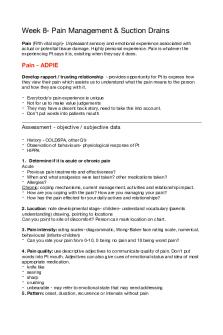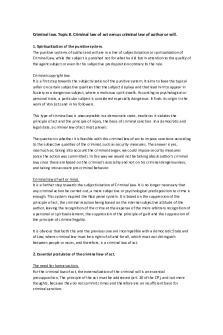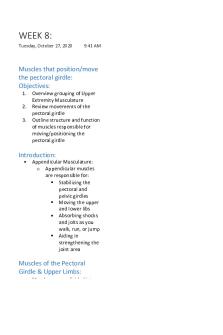Colorimeter - Lecture notes 8 PDF

| Title | Colorimeter - Lecture notes 8 |
|---|---|
| Author | Gearoid McCarthy |
| Course | Water Quality Instrumentation |
| Institution | Cork Institute of Technology |
| Pages | 10 |
| File Size | 629.8 KB |
| File Type | |
| Total Downloads | 39 |
| Total Views | 133 |
Summary
Eamonn butler...
Description
PHYS6038
Photometers Photometers aka colorimeters, spectrophotometers Principle: Add a specific chemical(s) to the water sample.A chemical reaction specific to the parameter( Mg,Ca, Fe, TOC etc) occurs. The absorption or transmission intensity of IR light is measured. This is used to estimate the concentration in mg/l of the parameter.
Advantages
very simple and straightforward.Much easier than some other chemical methods .. if you trust the result ! One single photometer used for a suite of parameters handheld meters available... in situ measurements possible manufacturers claim a massive range (200) of measurable parameters Disadvantages
Not continuous .. no inline probes..... grab samples only Different chemical required for each parameter... some methods may require intricate chemistry.... the procedure is different for every parameter sample is altered so can not be reused only one parameters can be tested at each time..... if you run a mass spec ( gaseous sample) you get all info in one scan Colorimeter vs Photometer terms are used loosely and interchangeably... difference is not clear generally In a colorimeter a particular band is selected .. in spectrophotometer single wavelength is selected. Effectively the photometer has better resolution In a colorimeter a filter is used to set the wavelength, whereas in spectrophotometer a monochromator or prism is used. They perform the same function, but photometers are more complex and sophisticated.
Typical Procedure: 1. Prepare a calibration curve from a set of known standards ... conc vs absorption.( stored by software) . 2. Load blank sample. This is the sample under test without the added reagents. Acquire spectrum A. This accounts for all the background absorption, from air, cuvette glass, sample itself and will be used to perform a background correction 3. Add reagents etc to give typically a specific colour change 4. Acquire spectrum B.
Water Quality Instr
33
PHYS6038
5. Spectrum A ratioed with Spectrum B will give the absorption effect of the analyte. From the calibration curve the concentration in mg/L can be determined. Note that this background subtraction method should also take account of gradual ageing in source and detector. More sophisticated models are dual beam (diagram below) which take account of any drift in source and detector in real time.
detector sees modulated signal.....ref/sample/ref/sample the ref will generally be constant..the sample signal strength will vary with conc discuss above diagram..... formula to convert transmittance to absorption
The amount of radiation absorbed or transmitted may be measured in a number of ways: Transmittance: T = P / P0, %T = (P / P0 )*100 Absorbance: A = log10 (P0 / P) A = log10 (1 / T ) A = log10(100 / %T)
A = 2 - log10 %T
Absorbance runs from 0-2 50% transmittance=absorbance of 0.3.
More detail: Typically the sample is mixed with reagents, which react specifically with the constituent (ions) to be analyzed. In most cases a colored compound or complex is formed. The intensity of the color is a measure of the concentration and can be quantified using UV/Vis Spectroscopy. Here the attenuation of radiation of a specific wavelength can be measured and a relationship between absorbance and concentration is made by establishing a calibration curve. The absorbance increases with the concentration of the analyte in the water. The Beer-Lambert law defines this relationship between concentration and absorbance: A = cd where A is absorbance at a defined wavelength,
Water Quality Instr
34
PHYS6038
is the molar absorption coefficient (depends on ion type and wavelength... will be constant for a particular combination) c is the concentration ....(what we are after) d is the path length (in cm).... will be constant is a substance-specific constant which remains unaltered during a specific analysis. The same is true for the pathlength, so that the absorbance measured is proportional to the concentration . An additional increase in sensitivity can be achieved by using cells with longer pathlengths. Before performing quantitative analysis , a calibration curve using reference solutions of known concentrations is established. When the Beer-Lambert law applies this calibration curve is linear. Modern UV/Vis spectrophotometers are equipped with the possibilities to select nonlinear curve fit, so that measurements outside of the validity of the Beer-Lambert law can be done in a limited extended range. It is usual practice to periodically check a stored calibration curve with references of known concentration of the analyte. Manufacturers blurb
Above is just a sample list of a wide range of parameters that can be measured. Note that the MDL should be...
Similar Free PDFs

Colorimeter - Lecture notes 8
- 10 Pages

8 - Lecture notes 8
- 21 Pages

8 - Lecture notes 8
- 21 Pages

8 Midwifery - Lecture notes 8
- 3 Pages

Taxation 8 - Lecture notes 8
- 2 Pages

Week 8 - Lecture notes 8
- 6 Pages

Dox 8 - Lecture notes 8
- 21 Pages

Lesson 8 - Lecture notes 8
- 2 Pages

Assignment 8 - Lecture notes 8
- 4 Pages

Week 8 - Lecture notes 8
- 23 Pages

WEEK 8 - Lecture notes 8
- 10 Pages

CL-8 - Lecture notes 8
- 12 Pages

Tema 8 - Lecture notes 8
- 8 Pages

Lesson 8 - Lecture notes 8
- 19 Pages

Chapter 8 - Lecture notes 8
- 7 Pages

Chapter 8 - Lecture notes 8
- 2 Pages
Popular Institutions
- Tinajero National High School - Annex
- Politeknik Caltex Riau
- Yokohama City University
- SGT University
- University of Al-Qadisiyah
- Divine Word College of Vigan
- Techniek College Rotterdam
- Universidade de Santiago
- Universiti Teknologi MARA Cawangan Johor Kampus Pasir Gudang
- Poltekkes Kemenkes Yogyakarta
- Baguio City National High School
- Colegio san marcos
- preparatoria uno
- Centro de Bachillerato Tecnológico Industrial y de Servicios No. 107
- Dalian Maritime University
- Quang Trung Secondary School
- Colegio Tecnológico en Informática
- Corporación Regional de Educación Superior
- Grupo CEDVA
- Dar Al Uloom University
- Centro de Estudios Preuniversitarios de la Universidad Nacional de Ingeniería
- 上智大学
- Aakash International School, Nuna Majara
- San Felipe Neri Catholic School
- Kang Chiao International School - New Taipei City
- Misamis Occidental National High School
- Institución Educativa Escuela Normal Juan Ladrilleros
- Kolehiyo ng Pantukan
- Batanes State College
- Instituto Continental
- Sekolah Menengah Kejuruan Kesehatan Kaltara (Tarakan)
- Colegio de La Inmaculada Concepcion - Cebu